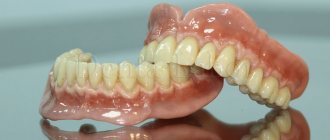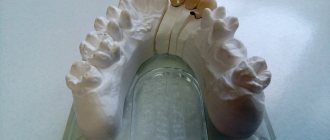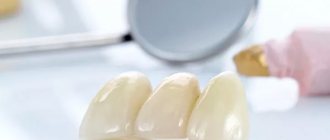03.02.2018
Dental prosthetic structures currently used have sufficient strength and durability. However, with improper or untimely care, they quickly lose their aesthetic qualities and become unsuitable for use. This is associated with the following undesirable consequences:
- Changing the color of the prosthetic structure. It becomes dull and loses its shine when exposed to food coloring and tobacco smoke.
- The appearance of unpleasant taste sensations due to irritation of the taste buds of the tongue by various bacteria.
- The appearance of small ulcers on the mucous membrane as a result of a large load on the oral mucosa when wearing a prosthetic structure. Neglect of observing the rules of personal hygiene can lead to the development of an inflammatory process in the oral cavity - stomatitis.
- Caries. If plaque accumulates on the surface of prosthetic structures, immediate action must be taken, otherwise holes may form.
- Inflammation of the gums. It usually begins with gingivitis, which, if left untreated, progresses to periodontitis;
- Bad breath resulting from the activity of bacteria that produce toxic substances.
To avoid all these consequences, you need to know how and with what to clean removable dentures. Care at home should be carried out in compliance with the rules and use of the products described below.
How to quickly get used to removable dentures
Naturally, each person is individual, and the duration of adaptation directly depends on the model and materials of construction. Conventionally, the process of addiction can be divided into three stages:
- irritation stage, which lasts about 7-10 days,
- stage of conditioned inhibition (duration – 3 weeks),
- the stage of full adaptation, when the patient completely gets used to the new artificial teeth (occurs after 30-40 days).
Immediately after installation, removable dentures may cause you nausea, increased salivation, changes or complete loss of taste, and difficulty eating. Diction problems also occur. But as you get used to the design, all manifestations disappear completely or are reduced to a minimum.
“Of course, there are patients who cannot get used to any removable dentures, even if they are made perfectly and in exact accordance with the bite. For example, with an increased gag reflex or if there is initially no psychological mood. In such situations, you need to look for alternatives and the best solution is prosthetics on implants, which is hundreds of times more comfortable and does not cause such unpleasant sensations.”
Chorny Stanislav Vladimirovich, orthopedic dentist, work experience more than 16 years
Can't get used to removable dentures? Dental implantation will solve all your problems. In 1 day and forever. Lifetime guarantee on doctors' work.
Free consultation
During the period of getting used to the prosthesis, you need to wear it constantly, without removing it while eating and sleeping. You should not use it in case of acute pain - it is better to consult a doctor to correct the design.
It is important to understand that any removable denture, especially if it is installed for the first time, will require regular correction. The gums sag along with the bone tissue, the position of the joint changes, the bite is adjusted - all this will lead to the fact that the prosthesis will seem uncomfortable. One visit to the doctor and the position of the device will change - you will become more comfortable. Remember this and do not ignore your doctor's recommendations.
How to store dentures correctly -
In this section we will tell you how to store dentures at home. Most often, patients do not know how to store dentures correctly, because removable dentures must almost always be removed at night. Keep in mind that improper storage can quickly lead to deformation of the prosthesis.
Soak the dentures overnight - for the first two weeks after making the denture, dentists recommend wearing the new denture almost all the time, without removing it, or removing it for a short period of time.
However, after two weeks, the tissues of the prosthetic bed need regular rest - at least 6 hours a day. Remember that most types of dentures must be kept moist to maintain their shape. When removing them for a long period, you need to place them in a solution of water or a special solution for soaking dentures (you can buy it at the pharmacy). Place the denture in water overnight. Do not keep dentures with metal elements in water that smells like chlorine - this may cause the metal parts of the denture to darken.
Important: remember that dentures can become deformed due to the following two reasons... Firstly, if the dentures dry out, and secondly, if you place them in hot water. After this, the shape of the denture will no longer fit the shape of your gums, and the denture will cause pain and discomfort when wearing or eating.
How to whiten dentures –
Denture whitening may be necessary if you have not taken good care of your removable dentures for a long time, which has led to their darkening (due to the attachment of pigment plaque and tartar). Whitening dentures using whitening toothpastes is highly not recommended, because... Such toothpastes have increased abrasiveness.
Remember that the surface of the denture is much less hard (than tooth enamel) and as a result is more susceptible to abrasion and scratches. Therefore, the use of whitening pastes will quickly cause irreparable damage to the prosthesis. The best means for whitening old dentures are an ultrasonic bath, an option using De'Longhi EcoDecalk liquid, and, again, Corega effervescent tablets. We hope that our article on the topic: How to store and care for removable dentures was useful to you!
Sources:
1. Personal experience as a dentist, 2. “Orthopedic dentistry. Textbook" (Trezubov V.N.), 3. "Removable dentures: a textbook" (Mironova M.L.).
How to restore diction
To restore diction, it is recommended to speak as much as possible: read books, pronounce tongue twisters, while holding one or more sweets in your mouth (without sugar! For example, Sula with mint or sea buckthorn).
15-20 minutes, several times a day. The duration of the course is the first 1.5-2 weeks after prosthetics. Tongue twisters for restoring diction after removable prosthetics
| For your convenience, we have selected several useful tongue twisters |
| The snout pig was white-nosed, blunt-nosed; I dug up half the yard with my snout, dug, dug. |
| Karl stole Klara's advertising, and Klara stole Karl's budget. |
| In Kabardino-Balkaria, valocordin from Bulgaria. |
| The fast talker quickly said quickly, That you can’t quickly talk all the tongue twisters, but you can’t over-speak all the tongue twisters, But, having quickly spoken, he quickly said, That you can’t talk all the tongue twisters, but you can’t over-speak. |
Caring for your gums while wearing dentures
A mandatory requirement for everyone who wears dentures is gum care . It can significantly reduce the need for professional treatment. First, gums need a break from removable dental structures for at least six to eight hours a day. This can be done both during sleep and during the day. Secondly, the gums must be regularly rinsed with a saline solution, after removing the dentures. Third, to prevent gum problems, you should eat healthy foods.
When wearing prosthetic dental structures, gum massage is useful, which should be carried out every day for five to seven minutes.
It improves blood circulation in the gum tissue and relieves pain. Gum massage can be done independently. It is performed by making circular movements of the thumb or index finger along the outer and inner sides of the gums. The duration of the massage should be two to three minutes, it is advisable to do it several times a day.
If, even with proper care, the gums are swollen or red, this may indicate inflammation as a result of wearing dentures. In this case, you should seek help from a doctor.
What hygiene products can be used
Hygiene products for the care of removable dentures
| Name | Description |
| Toothbrush | You will need a personal brush with soft bristles; too hard can lead to scratches in which bacteria will accumulate. We recommend the Curaprox brand – brushes with soft or ultra-soft bristles. They do not damage the plastic, but do an excellent job of removing plaque on the teeth, also cleaning it from under the gums. |
| Toothpaste | Low-grade, for example, Parodontax, ROCS To clean the prosthesis itself, you can also use children's paste - it is more gentle. |
| Irrigator | The device is necessary both for cleaning your own teeth, if they remain in the mouth, and for cleaning dentures - it effectively removes plaque and allows you to clean the interdental spaces very efficiently. |
| Citric acid and soda or tablets for cleaning and disinfection | Use for periodic cleaning and disinfection of structures - make solutions for rinsing the mouth or place dentures in them (applies to citric acid and soda). The tablets must be dissolved in water and the resulting solution must be used to soak the structure. |
What happens if you don’t take care of your dentures?
Poor care of removable dentures can lead to loss of appearance of the structures and also cause health problems. The most common consequences include:
- color change, loss of shine of the structure;
- ulcers on the oral mucosa;
- change in taste sensations;
- caries of natural teeth;
- bad breath;
- bleeding gums;
- periodontitis;
- stomatitis.
Therefore, check with your doctor in advance for details on care and hygiene. Follow the rules for wearing removable dentures, and the adaptation period will pass without consequences.
What to exclude from your diet
After installation of dentures, you will have to adjust your diet. Some foods will have to be abandoned forever, others only temporarily. The adaptation period will take several weeks. At this time, dentists recommend giving preference to soft and liquid foods.
If the patient has not previously worn dentures, he can begin adaptation with nutritional fluids, such as baby formula, fruit and vegetable juices, and chicken broth. Later, include puree soup, soufflé, puddings, mousses, porridge from finely ground cereals and mashed potatoes into the diet. You can also drink tea, coffee, strained compote, still mineral water and milk. For sweets, honey or jam without berry seeds is allowed.
Gradually, you can switch to soft foods and supplement your diet with boiled side dishes (potatoes, rice and pasta), eggs and unsweetened baked goods, which should be soaked before use. You can add dairy products: soft cheese, ricotta or cottage cheese.
After the adaptation period is completed, you can eat coarser and tougher foods, for example, pearl barley or buckwheat porridge. In this case, fruits, vegetables and meat need to be cut into small pieces.
There are foods that will have to be excluded from the diet forever. These include especially hard and sticky foods: nuts, cereals, croutons, chewing gum, toffees, caramel, chocolate and peanut butter.
It is also better to avoid strawberries, raspberries, blackberries, grapes with seeds, and baked goods with sesame seeds or poppy seeds. All of these products contain small seeds that can easily get stuck between dentures and gums.
When eating, try not to use your front teeth, as this may cause the dentures to move. Chew food on both sides of your mouth so that the load is evenly distributed on your teeth and your gums become accustomed to the pressure from the dentures. Chew your food slowly and thoroughly before swallowing.
What to do if the prosthesis rubs and does not fit well
- use ointments (Solcoseryl, Metrogyl Denta) or sea buckthorn oil. Apply the oil to the gums for a maximum of 20 minutes after eating and cleaning the denture 3-4 times a day,
- It is forbidden to sharpen dentures yourself, after which you can simply throw it away,
- If there is acute and constant pain caused by rubbing of the structure, you should consult a doctor for correction. 2-3 hours before the visit, the denture should be in the mouth so that the reason why the structure is rubbing becomes visible.
If the device is not fastened well, then you should contact your attending physician - an orthopedic dentist. If the correction does not help, you will have to use special fixation creams: Protefix, Corega, Lacalut Dent. Choose the one that suits you - according to taste, consistency, fixation time. Try different options and choose the best one.
Allergy to dentures
People with dentures often wonder: how to treat dentures for allergies? To begin with, it is worth understanding the essence of the problem. By this type of allergy, doctors understand the body’s negative reaction to the introduction of dentures (a foreign object), namely the rejection of a foreign body. This process is accompanied by irritation of the mucous membrane, redness and pain. After installation of an artificial jaw, allergies can manifest themselves in different ways: from several hours to a year or more.
Any part of the structure can act as an allergen: cement, paste, metal, stainless steel or any other alloy, plastic, etc. Accordingly, to solve the problem is to neutralize the stimulus. To do this, the first thing you need to do is determine what exactly the negative reaction was about. Next, the dentist either changes the element to another, to which the body is more tolerant, or covers it with special means (this can be a gel or spraying, depending on the material from which the part is made).
Important: if allergy symptoms are severe, you should immediately remove the denture from the oral cavity, and you can also take anti-allergy medications. After this, you need to go to the doctor for an appointment.
How to eat after installing structures
If the prosthesis is made of comfortable materials, if it suits you, then you will be able to eat well right away. Restrictions occur when little time has passed after the removal of living teeth, when you initially had gum inflammation. In such situations, pressure causes pain; you need to limit the chewing load to avoid discomfort and allow the gums to recover.
In general, during adaptation it is advisable to adhere to the following recommendations:
- give preference to soft and warm foods, exclude viscous foods,
- you need to chew carefully and thoroughly, cut food into small pieces,
- It is better to chew food on the side where the process does not cause pain,
- You should refrain from biting food with your front teeth.
After adaptation, when the prosthesis no longer causes pain, you can return to your usual diet. But you should exclude foods that are too hard, viscous, sticky, excessively hot and cold (drinks and soups should be warm, ice cream should be kept a little at room temperature).
Toothbrushes and pastes for daily hygiene of dentures
Artificial dentures naturally differ from natural teeth, but there are no strict restrictions on the use of toothbrushes and toothpastes. When choosing a paste for cleaning dentures, pay attention to the abrasive index. Manufacturers usually indicate the abrasiveness rating on the packaging. If it is above 70, this composition can be dangerous for your artificial teeth.
It is better to buy a brush with soft bristles and a small size. Hard ones scratch the surface of orthopedic structures, depriving them of shine and smoothness. A good option is toothbrushes for children with a comfortable, non-slip handle and a small head. Many well-known manufacturers produce products similar in shape and size specifically for owners of dentures.
How to clean dentures and remaining teeth
You need to brush your teeth exactly as you are used to: in the morning, in the evening and after every meal. But as for prosthetics, the recommendations will be as follows:
Daily care
- clean the structure in the morning and evening with a soft toothbrush using toothpaste without abrasives or regular soap (preferably baby soap). Pay special attention to the internal area that is in contact with the gum,
- Soak the denture daily in a solution of citric acid (1 teaspoon per 150 ml of warm water): soak it for 10 minutes to disinfect and loosen plaque. Carry out the procedure before brushing your teeth 2 times a day. Afterwards, rinse thoroughly with water. Change the solution every 3-5 days,
- after each meal, the structure is removed and thoroughly rinsed under running water,
- Additionally, you can use an irrigator, which will clean the microscopic gaps between the crowns of the structure,
- Be careful when brushing your teeth, especially if there are small parts - hooks, clasps, so as not to damage them.
Periodic care
- soak in a disinfectant solution - for this you need to purchase special tablets for removable dentures (Protefix, Corega, Lacalut Dent). Use up to 3 times a week while maintaining daily hygiene. Use according to instructions (keep in solution for 15-20 minutes),
- use products that suppress the activity of oral microflora (especially important several years after the installation of dentures, since more plaque accumulates on them). For example, “Tantum Verde” (spray, lozenges) - relieve inflammation and tension, freshen breath.
Modern equipment - ultrasonic sterilizers - can be used to disinfect dentures. They allow you to achieve ideal cleanliness of artificial teeth at home, cleaning them from bacteria and plaque. These devices can also be used to disinfect any other items - toothbrushes, baby bottles, etc.
Caring for removable dentures made of plastic
Plastic dental structures have gained wide popularity due to their low cost. They need careful and careful handling. Caring for plastic dentures can be done in a variety of ways, including:
- Rinse with water. Used to clean the dental apparatus from food particles after eating. For the procedure, use only boiled water. It is not recommended to rinse with running tap water as it may contain certain microorganisms.
- Individually selected hygiene products. These include a brush and paste. Cleansing is recommended twice a day, but experts advise cleaning plastic dentures after each meal. This is necessary because such structures have a porous surface into which food particles and bacteria can penetrate, and this contributes to rapid contamination. Removable dentures can darken from daily consumption of products containing dyes (coffee, tea, concentrated juices). When brushing, the direction of the brush should be from the gums to the edge of the plate to prevent plaque from penetrating under it.
- Use of disinfectants. At night, remove the product and place it in a container with a disinfectant solution. With the help of this treatment, contaminants, microbes, and particles of agents used for gluing are removed. Such products can be purchased at pharmacy chains or specialized points of sale in the form of liquids or tablets.
- Using an irrigator. Thanks to such devices, you can completely clean products from plaque and bacteria that accumulate even in hard-to-reach areas. Also, with the help of such a device, the microcirculation of blood fluid in the gums improves, as a result of which their condition improves.
- Using tablets that dissolve in water. They contain acids, enzymatic and bleaching substances, due to which whitening, removal of microbes and disinfection of the surface of products occur.
- The use of modern means, which include ultrasonic baths, thanks to which cleansing occurs in a non-contact way, plaque, tartar, and unpleasant odor are removed.
- Professional teeth cleaning at the dentist. To do this, once every 6 months you should visit a specialist to undergo a preventive cleansing procedure to check the condition of the structure.
Do I need to remove dentures at night?
Modern “removers” can be worn constantly and it is not necessary to remove them at night – especially during the first 2-3 weeks, while adaptation to the designs occurs. However, outside the oral cavity, dentures with a plastic base should NOT be placed in a humid environment, since favorable conditions are created for the development and growth of pathogenic microflora. This can lead to bleeding and gum inflammation.
If there are metal elements, the prosthesis must also not be stored in tap water, especially chlorinated water - this can lead to metal corrosion.
For storage and transportation, it is necessary to use specially designed protective ventilated boxes/cases in which the prosthesis will be kept clean and dry.
Give up removable dentures forever! Consultation + diagnosis + treatment plan FREE. Find out which dental implantation method is right for you in 1 day!
Enroll now
Basic storage rules
Grandparents can tell you that previously the “jaw” should have been placed overnight in a mug or glass of clean, cold water. It's all about the materials used in production. The rubber contained in the composition needed to be protected by a moist environment from cracking and drying out, as a result of which it became excessively fragile.
Innovative modern options no longer require such manipulations. The main place in which it is recommended to save them is the mouth itself, and not anything else. Silicone, acrylic, nylon and other materials do not require storage in liquid. You can purchase a special container that prevents dirt and dust from settling on the surface, but a clean cotton handkerchief or a piece of gauze folded several times will also work. However, it is best to consult with a doctor at the Dentika clinic, who will give clear and competent instructions on how to properly treat different materials.
Is it possible to whiten dentures?
If hygiene is insufficient, dentures may change their shade. But, unfortunately, it is impossible to bleach it to its original state, especially if a lot of plaque has accumulated and the coloring pigments have penetrated deep into the pores of the material. The doctor can perform polishing - the prosthesis will be smoother, its top layer will be a little ground off, so the structure will be visually lighter. At home, you can try using special whitening tablets (for example, Corega), but you should not overuse them - they can damage the prosthesis materials.
Methods for cleaning products
How to clean dentures? There are several methods of cleaning and bleaching - physical (mechanical, temperature, ultrasonic) and chemical. They are most often used in combination both at home and in the office of a hygienist or orthopedic dentist. Let's take a closer look at how to clean removable dentures from plaque and pigmentation.
Cleaning and whitening removable dentures at home
How to clean removable dentures at home from tartar, dark and yellow plaque, and nicotine? Here a special brush or a regular soft one, special solutions (tablets, powders), and an ultrasonic bath are used. It is recommended to use them comprehensively, i.e. All these devices and tools should be at home.
Toothbrush – special or regular soft
The brush cleans the surface mechanically, and you can use it to whiten teeth on a removable denture if the contamination is light, the plaque is soft and fresh, and there is no stone. The head of the instrument and the prosthetic device itself are moistened with warm water (no more than 60 degrees Celsius), and cleansing is carried out using sweeping movements.
Here is a list of useful tips that will tell you how to properly clean removable dentures at home:
- removable ones made of acrylic, nylon are cleaned by removing them - i.e. holding the structure in one hand and the brush in the other,
- conditionally removable (clasp, “sandwiches”) can be cleaned both in the mouth and in the hand - but in the latter case, not every day, but about once a week,
- You will need to remove the “jaws” in any case - you can never wear them without removing them: because Plaque and stone also accumulate under the base. In order for it to form less, it is necessary to exclude sticky foods (taffy, for example) and rinse your mouth after each snack,
- it is preferable to use an irrigator, which, due to a directed stream of water, cleans the most inaccessible places,
- Finally, you need to rinse the product in clean water or rinse your mouth (if it was cleaned in your mouth).
Special pastes and gels
How to clean dentures at home? In addition to a special brush, orthopedic dentists recommend using additional products - pastes (for children or specialized). Their main purpose is to remove soft food plaque, eliminate harmful microorganisms, and freshen the oral cavity for a long time.
Orthopedic toothpastes and gels are used on a daily basis along with a brush. One or two peas of the product should be applied to the damp bristles and begin cleaning the structure. After thoroughly working all areas, rinse the product in clean water or rinse your mouth. Popular brands of cleaning products are CURAPROX daily, Corega, Silcamed, ROCS. Their composition is quite gentle and does not contain harmful or brightly colored components, so that prosthetic materials with cracks on the surface do not acquire an unnatural shade.
When understanding how to clean and how to whiten dentures that have darkened, you need to understand that toothpastes will not cope with whitening stubborn pigmentation and tartar. But they are quite suitable for maintaining an aesthetic appearance. Use regular whitening pastes with an RDA (abrasiveness) index of more than 100 units. prohibited - they will scratch the acrylic gum or plastic of artificial teeth. Pastes and gels with a whitening effect, which contain a high concentration of carbamide peroxide or hydrogen peroxide, can spoil materials.
Tablets and solutions
What else can you use to clean dentures? A more effective or deep cleansing method is weekly soaking in a special solution. Some manufacturers produce ready-made solutions for cleaning and whitening - for example, CURAPROX weekly, Isodent. They, like pastes, will help with not very strong and recent darkening and pigmentation. Such solutions are used in conjunction with storage containers and ultrasonic baths. The maximum effect is observed from solutions that need to be made on the basis of whitening tablets for dentures - for example, Protefix, Dent Frash, Fittydent super, Corega Whitening.
The prosthetic structure must be immersed in the solution for 5-15 minutes. It is made like this: 1 tablet + 150 ml of warm water no more than 60 degrees Celsius. Cleaning, disinfecting and bleaching the product is achieved through the action of the active substances of the solution - released oxygen, silver ions, enzymes, sodium perborate, citric acid and soda (each manufacturer uses a different combination of components). After soaking, the product is cleaned with a brush dipped in the solution, washed with water, and the solution is immediately poured out after use.
Ultrasonic bath
As an addition to the brush, pastes and solutions, you can use an ultrasonic bath or “wash” once every 1-2 weeks. Bradex brand bathtubs have proven themselves well. A nice bonus is that you can clean jewelry in them without worry.
Professional cleansing in the clinic
How and with what to whiten removable dentures in the clinic? Dentists have powerful tools at their disposal, incl. ultrasonic, devices that can clean almost all types of dirt, plaque, large amounts of stone. But provided that the pigment is not old - otherwise the denture cannot be bleached to its original state! For example, even professional methods will not help against blackness that has formed on teeth for a very long time. The structure will whiten only a few shades, but not to perfection.
Using hardware, you can bleach and clean classic plastic and acrylic orthopedic structures, modern “Acry-free” and “Quadrotti”, acetal, and polyurethane. An ultrasonic bath, for example, Easyclean, has a wave frequency of 37 kHz (this is 7 times more powerful than a device for home use). How to clean dentures with it? The contaminated product is lowered into it, filled with liquid - and during the cleaning process it can heat up to 80 degrees Celsius, and ultrasonic waves knock down pigmented plaque and stone.
Another highly efficient device is the Sympo from Renfert. The denture is placed in a special glass, at the bottom of which there are many metal needles, filled with liquid, closed and placed in the device. The operating principle is based on a rotating magnetic field. Under its action, the needles begin to move and remove all organic growths on the prosthesis without damaging the product itself. Suitable for cleaning and whitening stubborn stains, smoker stains, and for lovers of strong coffee.
How to know when it’s time to change your dentures
It is recommended to change dentures every 3-5 years or 5-7 years (depending on the material and type of construction).
When using removable dentures, the load from chewing food on bone tissue is only insignificant, which is fraught with its gradual resorption. The jawbone decreases in size, and not always evenly. This process takes from six months to several years and leads to a discrepancy between the shape of the prosthesis and the relief of the gums - the prosthesis is less secure and becomes less stable. This means relocation (if possible) or complete replacement of the structure is required.
In addition, materials wear out over time under the influence of saliva, nicotine, food irritants, and mechanical stress. Cracks appear on the structure, the surface becomes less smooth, which contributes to the accumulation of a large amount of plaque. If you have chosen crowns made of plastic (namely, they are in most cases used in removable orthopedic devices), it is worth considering that they wear down quite quickly, so after about 2-3 years the bite changes, which can affect the condition of the joint and the process of normal chewing food.
The best ways to preserve and maintain smile aesthetics
What is the best way to clean removable dentures? If they are very dirty, or there are stone build-ups, then the only possible way to whiten is to go to the dentist for hardware cleaning. But even here it is not always possible to return restorations to their original shade. To prevent loss of aesthetics, it is necessary to regularly clean artificial teeth at home - with a special brush, paste, and disinfectant solutions. The dentist will advise which product is best to use at home after prosthetics. It is also recommended to treat brightly colored foods and drinks without fanaticism, to give up cigarettes or reduce their quantity - in any of the above situations, oral hygiene should be strengthened.
How to whiten a nylon denture
The service life of a nylon prosthesis depends on care and gentle use. Daily brushing and rinsing with solutions will help prevent plaque from appearing. For severe contamination, use tablets. Regardless of the condition of the teeth, ultrasonic cleaning is carried out in the dentist’s office every six months. The doctor will tell you how to whiten a nylon denture without damaging the structure of the artificial teeth.
It is recommended to get rid of smoking and other habits that “color” the material. For whitening, special brushes are used, and instead of a paste, a solution based on tablets is used. Tablet preparations remove plaque, whiten, and remove bacteria. It is better to select a product together with a specialist.
Doctors recommend using products from one manufacturer. So tablets, a brush, cleansing gel or toothpaste from one company will have a prolonged whitening effect. It is not advisable to use aspirin, soda, lemon juice and other traditional methods for whitening; the risk of damaging teeth increases significantly.
A nylon product can retain its attractive appearance and functionality for years. Professional cleaning of teeth (dentures), regular examination by a specialist, properly selected care and careful use are the key to long service life of dentures. When using any cleaning products, it is better to follow the instructions.
Features of wearing removable dentures
Removable dentures have some features. When designing removable dentures, it is impossible to take into account several factors that can only appear while wearing the dentures. This is the degree of pressure of the prosthesis on the gum and the degree of fixation of the prosthesis. It happens that at first patients are concerned about pain when wearing dentures.
Correction of removable dentures
Correction of removable dentures - grinding of the structure in places of contact with the oral mucosa - is carried out the next day after installation of the denture. During the first two weeks of wearing the structure, several adjustments to the prosthesis may be required.
The correction procedure is carried out in the dental office by the attending dentist. Before visiting a doctor to have your denture adjusted, be sure to wear it and walk around with it for at least three to four hours. Also, do not carry out self-correction of a removable denture using improvised tools. At best, this will completely disrupt the fixation of the prosthesis, and at worst, it will lead to a breakdown, after which it is impossible to restore the structure - you will have to make a new one.
If the denture rubs the gum
Some patients, when wearing dentures for the first time, complain that the structure rubs their gums. This is the result of the oral cavity “getting used to” a foreign object. In order to get rid of unpleasant sensations, consult a doctor - he will correct the prosthesis. Don't tolerate discomfort. In the place where the prosthesis rubs, an inflammatory process can form, and healing due to constant friction is almost impossible. If you cannot get to the orthopedist who installed the prosthesis for you, you can turn to us for a service - at the clinic on Shchelkovskaya. An experienced specialist will see you and help you adjust the prosthesis so that nothing bothers you. Just call 8 (495) 033-00-63 or leave your details in the registration form on our website.
Fixation of the prosthesis
The anatomical features of the jaw structure in some people create obstacles to comfortable wearing of dentures. In such cases, you can use a special fixing gel, which is applied in a thin line to the prosthesis. This gel is completely invisible to humans and is absolutely safe. It is better to choose a gel in consultation with your doctor.
Broken prosthesis
During the use of prostheses, due to various factors, the prosthesis may break, as well as cracks and chips. In such cases, you must immediately consult a doctor to repair the structure. The repair period for a prosthesis is up to three days; making a new design (if the old one cannot be corrected) takes a week.
Frequently asked questions from users
Question from Tatyana R.: Hello, is it possible to whiten dentures with whitening strips? I have clasps, and my teeth are darkened on them, and the toothpastes don’t help at all.
ANSWER: Hello, Tatyana. Using whitening strips, you can seriously harm your supporting teeth and gums if the active gel from them penetrates under the denture. Even if there is a microscopic gap between the hooks or attachments and the gum, this is quite likely. If you whiten the denture in strips after removing it from your mouth, this is also not the best solution - stains and cracks may appear on the base and teeth. To clean orthopedic structures, it is better to contact dentistry. The doctor will assess the condition of the dentures, clean and polish them using professional methods. But if the pigmentation has penetrated very deeply into the coating, repair or replacement of the prosthesis may be required.
[1] Lebedenko I.Yu. Prosthetic Dentistry: National Guidelines, 2021.
Author: Dulgarov Zh. G. (Thank you for your help in writing the article and the information provided)
Getting used to the artificial jaw
Before wearing a removable denture becomes comfortable, each patient goes through an adaptation stage.
The orthopedic design is initially perceived as a foreign body, which can affect the patient’s taste and general well-being:
- the perception of temperature and taste characteristics of food changes;
- discomfort, irritation, gag reflex, increased salivation occur;
- the patient may bite his cheeks and tongue;
- there are difficulties in pronunciation and chewing food.
The duration of the adaptation period is individual for each patient. As a rule, after a week the irritation stage passes. Speech with a new prosthesis returns to normal after about 3 weeks, and with constant use, complete adaptation occurs within a month.
How to make it easier to get used to dentures: expert advice
- under the guidance of a dentist, master the skills of independent use of orthodontics (how to put on and take off);
- during the first 2 weeks, try to wear dentures around the clock, removing them only for washing, disinfecting the product and oral hygiene;
- rinse your mouth often with water, drink warm tea;
- use high-quality means for fixing the prosthesis;
- the first few days, give preference to soft foods;
- try to chew slowly, thoroughly, on both sides at once;
- To quickly restore speech, read aloud for 1-2 hours a day, pronounce tongue twisters, talk while holding nuts or candies in your mouth.
Mistakes in caring for dentures
If the above rules are followed, dentures will last a long time. However, the following actions can significantly reduce their shelf life:
- Eating viscous food threatens to disrupt fixation.
- Eating food that is too hard will cause the artificial tooth to break off.
- Using a denture if it breaks carries the risk of injury to the oral mucosa.
- Rinsing with too hot water risks deforming the structure.
- Cleaning your denture over a sink may cause damage and may cause it to fall out of your hands. To prevent this from happening, use a towel.
Service life of removable dentures
If you follow the rules and provide regular care for your removable dentures, the design will last you a long time. The minimum service life of prostheses is three years. The production of new prostheses after a certain period of time is extremely necessary - wearing outdated structures causes bone tissue atrophy and “sagging” of the lower part of the face.
When wearing removable dentures, it is important to visit a dentist at least twice a year. The doctor relines the prosthesis - restoring a tight fit of the prosthesis to the jaw. The doctor also examines the general condition of the oral cavity, which allows timely detection and treatment of inflammatory processes.
If you feel severe discomfort while wearing removable dentures, dry mouth, pain, then contact your dentist as soon as possible - he will help identify the causes of symptoms and carry out the necessary restorative procedures.










